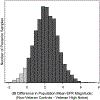Envelope following response measurements in young veterans are consistent with noise-induced cochlear synaptopathy
- PMID: 34293505
- PMCID: PMC10857793
- DOI: 10.1016/j.heares.2021.108310
Envelope following response measurements in young veterans are consistent with noise-induced cochlear synaptopathy
Abstract
Animal studies have demonstrated that noise exposure can lead to the loss of the synapses between the inner hair cells and their afferent auditory nerve fiber targets without impacting auditory thresholds. Although several non-invasive physiological measures appear to be sensitive to cochlear synaptopathy in animal models, including auditory brainstem response (ABR) wave I amplitude, the envelope following response (EFR), and the middle ear muscle reflex (MEMR), human studies of these measures in samples that are expected to vary in terms of the degree of noise-induced synaptopathy have resulted in mixed findings. One possible explanation for the differing results is that synaptopathy risk is lower for recreational noise exposure than for occupational or military noise exposure. The goal of this analysis was to determine if EFR magnitude and ABR wave I amplitude are reduced among young Veterans with a history of military noise exposure compared with non-Veteran controls with minimal noise exposure. EFRs and ABRs were obtained in a sample of young (19-35 years) Veterans and non-Veterans with normal audiograms and robust distortion product otoacoustic emissions (DPOAEs). The statistical analysis is consistent with a reduction in mean EFR magnitude and ABR wave I amplitude (at 90 dB peSPL) for Veterans with a significant history of noise exposure compared with non-Veteran controls. These findings are in agreement with previous ABR wave I amplitude findings in young Veterans and are consistent with animal models of noise-induced cochlear synaptopathy.
Keywords: Auditory brainstem response; Cochlear synaptopathy; Envelope following response; Frequency following response; Hidden hearing loss; Noise-induced hearing loss.
Copyright © 2021. Published by Elsevier B.V.
Conflict of interest statement
Declarations of Competing Interest None.
Figures







References
Publication types
MeSH terms
Grants and funding
LinkOut - more resources
Full Text Sources
Miscellaneous

